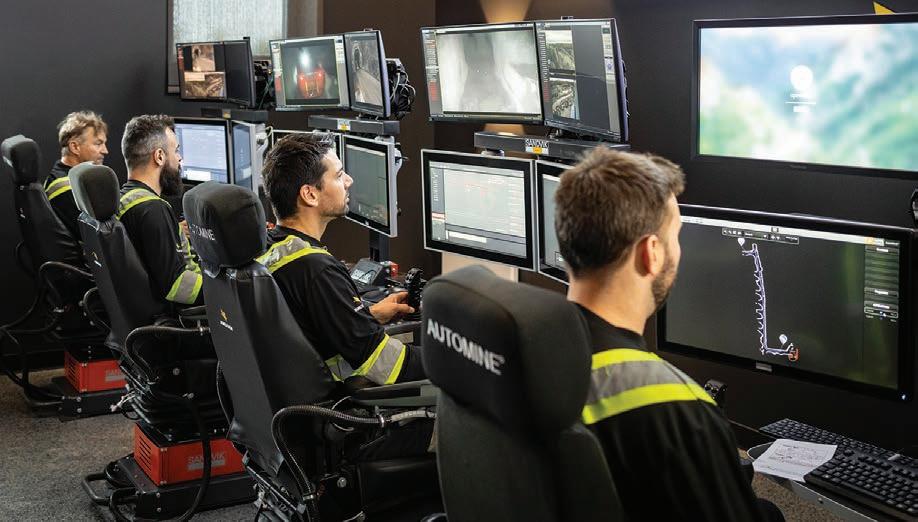
4 minute read
AUTOMATION & IOT
Digital tech boosts output for gold miners AUTOMATION | Real-life benefits include lower emissions, safer work sites
Meliadine mine in Nunavut.
BY KELSEY ROLFE
The digital transformation is well underway, with many mining companies increasingly turning to automation and internet of things (IoT) technology to make their operations safer and more efficient.
Senior executives from Agnico Eagle Mines (TSX: AEM; NYSE: AEM), Alamos Gold (TSX: AGI; NYSE: AGI) and Eldorado Gold (TSX: ELD; NYSE: EGO) told The Northern Miner about the projects underway at their own operations and the automation and IoT trends they expect to see in the next few years.
“Automation and digital technology are fundamental to our business going forward,” Simon Hille, senior vice-president of technical services and operations at Eldorado, said in a recent interview.
At both Alamos and Eldorado, underground mine workings have been major focus areas for automation and IoT projects over the past few years, from tele-remote equipment to automated hoisting and material handling systems.
A major automation project at Alamos’s Young-Davidson operation near Matachewan, Ont. has delivered “substantial improvements” to the site’s productivity since it was commissioned in mid-2020, said Luc Guimond, the company’s vice-president of operations. Guimond said the company’s two years of operating experience is informing the ongoing major expansion and automation project at its Island Gold mine, which will double production from 1,200 tonnes per day to 2,400 and reduce the mine’s truck fleet by half.
24/7 operation
As part of a lower mine expansion, Alamos introduced a fully automated skipping system in its main production shaft at Young-Davidson. It moves ore over a 60-inchwide conveyor into two storage bins and can deliver 725 tonnes of ore per hour — exceeding its production target of 8,000 tonnes per day.
The system, which is managed by one hoist operator at surface on a computer system, was designed to be able to continue skipping between work shifts and is in operation 24 hours a day. Young-Davidson’s new automated material handling system, comprising three conveyors and ore and waste feeder units, is controlled by the same operator at surface.
“It’s a lot more reliable relative to running with a trucking fleet,” Guimond said. “There’s more consistent movement of ore through the lower mine infrastructure that’s allowed us to demonstrate those efficiencies over the last couple of years.”
The company also now has loadhaul-dump units with remote capabilities underground, which has allowed operators to control the vehicles from a safe and remote location. Guimond noted that the company’s production schedule includes 10-hour shifts followed by a two-hour clearing window when the company does any underground blasting. Having auto- mated remote-controlled scoops allows Alamos to continue extracting ore during that window while the blasting contaminants clear.
Eldorado recently finished installing Newtrax Technologies’ underground network system and Pitram’s software for managing and measuring underground fleet activities at its Lamaque mine in Quebec to accommodate tele-remote equipment.
“Tracking and measuring our equipment better makes a huge difference to where the opportunities are, and being able to have the data to do the analysis to then make a difference,” Hille said. Eldorado had been “pushing really hard” to install the same systems at its Olympias mine in Greece this year but supply chain snarls have delayed the tele-remote project until 2024.
At Agnico Eagle, the company has spent years rolling out cellular networks at its mines, which Michael Wilson, corporate director for operational technology said have been “game changers as enablers for automation.”
Agnico’s 2018 implementation of an underground LTE and 4G network at its LaRonde and LZ5 mine in Quebec supports its automated mucking and hauling operations there. In the past year it completed an above-ground 5G network and an automation sys- tem at its Kittilä mine, and plans to test and commission an automated mobile fleet at the Finnish operation in the first quarter of this year.


Luc Girard, superintendent of mining operations at the LZ5 mine, said automated mucking and hauling is limited to isolated zones at both LaRonde and LZ5 due to safety considerations. At LaRonde it’s used to keep workers away from the face and limit their exposure to potential seismic activity, and at LZ5 automated equipment improves productivity between workers shifts.
Mucking and hauling operations have also been automated at the
Natural Resources
Trusted. Independent. Committed.
But Wilson said it still takes a long time to reach a high level of reliability with automation: Agnico’s fleet has an average of 75% availability when operated mechanically, and 40% when automated. He attributed the challenges to maturing technology, “the many interconnected electronic components and functionalities” and supply chain challenges. He also noted that automation is complex and requires many teams on site to work closely together.
Harnessing data
Miners are also increasingly focusing on harnessing geological and operational data to make better decisions.
Eldorado recently finished a years-long project to upload drill hole data from all of its operations into the cloud to enable collaboration across the organization, using technology from Leapfrog and Seequent.
“One of the areas we’re looking at is how can we connect our people a bit better, not just at site, but driving collaboration from one site to the next,” said Jaime Awmack, senior director of operational support. “We’re trying to look for those ways to learn from each other.”
This type of collaboration was previously impossible due to the massive file sizes of geological data and models taking days to run, Hille said.
Awmack’s team is now doing the same for the company’s production data, such as conveyor speeds, pump flow rates and failure instances, vibration analysis, equipment speeds and more, which she said is a key focus for 2023. The initial focus is to identify and analyze patterns, which could allow the company to implement predictive maintenance at its sites.
Wilson said the company spent 2022 “building interconnectivity of our equipment and IT networks to allow real-time global data transfer and centralization” and plans to








